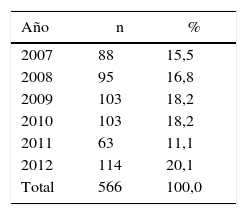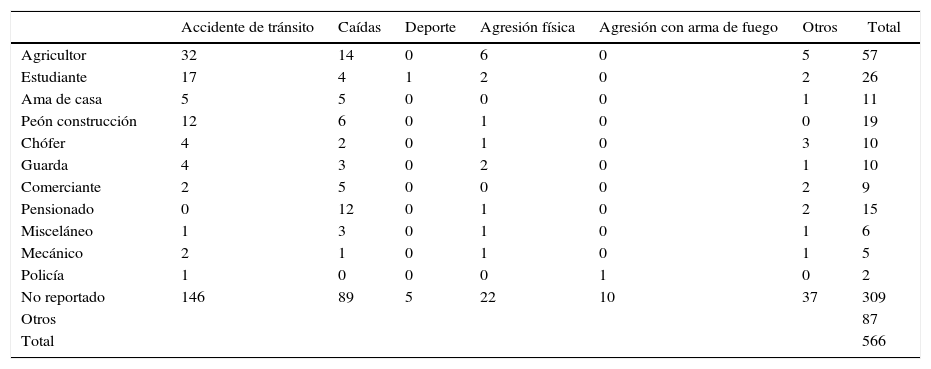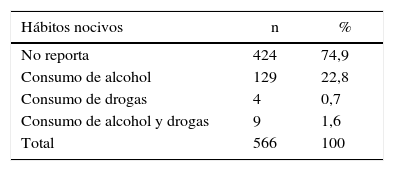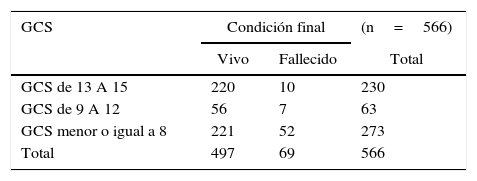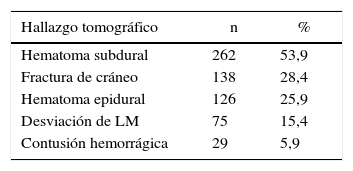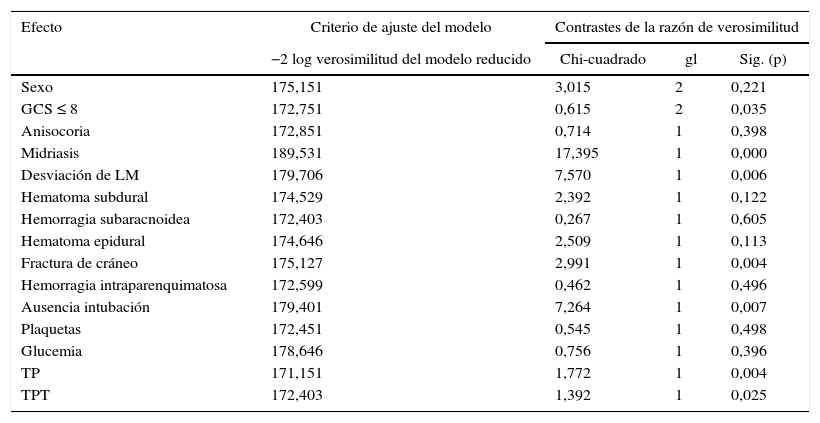Elaborar el perfil epidemiológico de los pacientes que sufrieron traumatismo craneoencefálico (TCE), ingresaron al servicio de emergencias y fueron atendidos por Neurocirugía del Hospital Dr. Rafael A. Calderón Guardia (HCG) durante el período 2007 a 2012.
Material y métodosSe realizó un estudio observacional, descriptivo, retrospectivo y de corte transversal de todos los pacientes con TCE que fueron admitidos al servicio de emergencias del HCG durante el período 2007 a 2012. Se registró un total de 721 casos, de los cuales se obtuvieron 566 expedientes, que contaban con las variables planteadas en esta investigación, excluyendo aquellos con información inconclusa o inconsistente.
ResultadosSe determinó que el sexo masculino registró la mayoría de los casos. La media de edad general fue de 46años, con una mediana de 43años y una desviación estándar de ±21años. La mortalidad fue del 12,69% (n=69). Los accidentes de tránsito fueron la causa más frecuente del TCE (n=259 personas) en el grupo etario de 25 a 44años, seguido por las caídas (n=174). Se observó que la mayoría correspondió a agricultores, en segundo lugar a estudiantes y en tercer lugar a peones de construcción.
Un 71,6% de los casos no reportaron ninguna enfermedad crónica asociada.
Con relación a la presencia de alcohol y otras drogas, un 74,9% no se reportó, mientras que en el 22,8% reportado se evidenció la presencia de alcohol.
Los parámetros clínicos y de laboratorios que tuvieron significación estadística (p<0,05) fueron Escala de coma de Glasgow (GCS) igual o menor a 8 (p=0,035), presencia de midriasis (p=0,00), desviación de la línea media (LM) (p=0,006), fractura de cráneo (p=0,04), ausencia de intubación al ingreso (p=0,007), tiempo de protrombina (TP) prolongado (p=0,04), tiempo parcial de tromboplastina (TPT) prolongado (p=0,025) y presión arterial media (PAM)<60 (p=0,002).
El procedimiento quirúrgico más frecuente fue la craneotomía más drenaje de hematoma solo o asociado con algún otro procedimiento (esquirlectomía o monitorización de la presión intracraneal [PIC]) (n=298).
ConclusionesSe encontró una especial dificultad para establecer estandarización entre los estudios epidemiológicos sobre TCE mundialmente, debido a los diferentes criterios utilizados para su elaboración. De la presente investigación se desprende que la población que mayoritariamente sufre este tipo de lesiones corresponde a adultos menores de 45años. Los accidentes de tránsito son la principal causa de dichas lesiones (45,8%), en combinación con el consumo de alcohol, y sus consecuencias se agravan cuando las víctimas presentan enfermedades crónicas como hipertensión arterial (HTA) y diabetes mellitus (DM). En cuanto a los indicadores postraumáticos relacionados directamente con pronóstico reservado, se determinó que una puntuación en la GCS igual o menor a 8, la PAM menor de 60, la prolongación en los tiempos de coagulación, la presencia de midriasis y la fractura de cráneo tienen asociación directa con el desenlace negativo o fatal para la víctima.
To determine the epidemiological profile of the patients who suffered traumatic brain injury (TBI) and were treated at the Dr. Rafael A. Calderón Guardia Hospital (HCG) Neurosurgery department, during the period from 2007 to 2012.
Material and methodsAn observational, descriptive, retrospective and cross section study was performed on all the patients with TBI and who were admitted to the emergency room of the HCG during the period 2007 to 2012. There were a total of 721 cases, of which 566 records were obtained of patients who had the variables established in this study, excluding those with incomplete or inconsistent information.
ResultsThe present study established the epidemiological profile of the TBI in the population seen during the period 2007 to 2012 at the HCG. It was determined that the male sex made up the majority of the cases were male, with mean age of 46 years. The mortality rate was 12.69% (n=69). Car accidents were the most frequent cause of TBI (n=259 persons) in the age group of 25 to 44years, followed by falls (n=174). It was observed that the majority were farmers, followed by students, and then construction workers.
No chronic illnesses were recorded in 71.6% of the medical charts.
No alcohol or other drugs were reported in 74.9% of the cases, while there was evidence of the presence of alcohol recorded in 22.8%.
The clinical and laboratory parameters that had statistical significance (P<.05) were GCS equal to less than 8 (P=.035), presence of mydriasis (P=.00), deviation of the LM (P=.006), cranial fracture (P=.04), lack of endotracheal intubation on admission (P=.007), prolonged PT (P=.04), prolonged PTT (P=.025), and MAP<60 (P=.002).
The most frequent surgical procedure in the study population was craniotomy with hematoma drainage alone or associated with some other procedure (esquillectomy or monitoring of PIC) (n=298).
ConclusionsThere is great difficulty in determining the epidemiology of TBI worldwide, due to the lack of standardisation of the international studies. From the present study, it can be concluded that the population that mainly suffers from this type of lesion are adults under 45 years old, with car accidents being the main cause of these lesions (45.8%) in combination with alcohol consumption. Also, the consequences of such are aggravated when the victims present with chronic diseases such as, systemic arterial hypertension and mellitus diabetes. As regards the post-traumatic indicators directly related to a poor outcome, it was determined that a GCS score equal to or less than 8, a mean blood pressure less than 60, the prolongation of the coagulation times, the presence of mydriasis, and skull fractures, have a direct association with the negative or fatal outcome for the victim.
Article

If it is the first time you have accessed you can obtain your credentials by contacting Elsevier Spain in suscripciones@elsevier.com or by calling our Customer Service at902 88 87 40 if you are calling from Spain or at +34 932 418 800 (from 9 to 18h., GMT + 1) if you are calling outside of Spain.
If you already have your login data, please click here .
If you have forgotten your password you can you can recover it by clicking here and selecting the option ¿I have forgotten my password¿.





